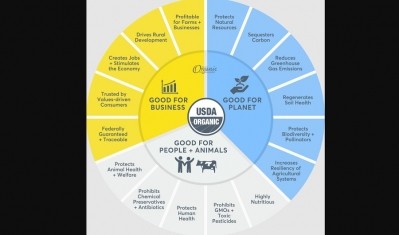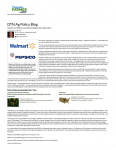OTA’s Farm Bill wish list focuses on creating responsive organic standards, reinforcing organic supply chains and enhancing conservation

With US organic sales growing to $63bn last year and representing more than 10,000 businesses and voices from across the value chain and nation, OTA CEO Tom Chapman noted that organic is one of the country’s fastest-growing food production and processing categories and holds significant promise for the future. But, he added, it also faces core challenges that Congress must address in the next Farm Bill. These include a lag in enacting industry agreed upon updates to the organic standards to align with industry and consumer expectations of the certification, a need for additional research to address challenges and improve conservation practices, barriers hindering new farmers from adopting organic practices and certification and threats to the program’s and products’ integrity.
To tackle these challenges, OTA in partnership with the Farmers Advisory Council and nearly 300 certifiers, growers, consumer-facing brands, retailers and non-profit organizations gathered at workshops the trade group hosted, identified three priority areas to advance the sector’s shared goals around growing the global marketplace and bringing further economic benefits to US producers, said Britt Lundgren, secretary of OTA’s board of directors and director of organic and sustainable agriculture at Stonyfield Farm.
She added the trade group’s priorities for the 2023 Farm Bill “center around responsive organic standards, supporting thriving farmers and advancing more resilient supply chains in the organic sector.”
Establishing responsive organic standards
OTA’s first priority focuses on establishing responsive organic standards, including requests to increase funding for the National Organic Program, establish a clear timeline and strategy to continuously improve the program and rebuild and reinforce public confidence in the organic standard.
Establishing responsive organic standards “really starts with making sure the USDA has adequate funding to do their job,” which over the course of the last 20 years through multiple past Farm Bill reauthorizations “finally got to a level that allows the agency to do the work that needs to be done to maintain the standards and to maintain the organic industry,” Lundgren said.
"That is not to say, though, that more can’t be done,” which is why OTA is calling for a 10% increase in funding annually for NOP to keep pace with industry growth.
“We are at a place now where the Farm Bill authorizes $20m per year to support a $60b a year industry. We think that’s a pretty good bargain for the government and we want to see that funding continue to keep pace with growth with a 10% increase each year to $24m per year authorization over the life of the Farm Bill,” she said.
In addition, OTA wants the Farm Bill to sustain mandatory funding of $5m for NOP to upgrade and maintain its technology systems, which Lundgren said is especially important as the organic program “moves into this new era of strengthening organic enforcement.”
Bolstering continuous improvement
The National Organic Program was always intended to be a living program that evolved to meet the changing needs of the industry as well as consumer expectations. However, many of the recommendations approved by stakeholders have stalled in recent years – prompting the trade group to call for a more predictable timeline for reviewing and updating the organic regulations in a way that meets consumer expectations in the evolving market place.
“We’re also looking to increase NOP oversight of certifiers so that we can ensure that standards are interpreted and implemented consistently, and this includes integrating material review organizations into the existing certification system to make sure that that process is a part of overall organic accreditation and third part material review,” Lundgren said.
She added this will build on recently the recently finalized Strengthening Organic Enforcement rule published in the Federal Register last month, with the goal of assuring consumers when they “see the organic label in the store they can trust that means what it is suppose to mean.”
Enhanced conservation to support ‘thriving American Farmers’
As part of OTA’s platform to support thriving farmers, the trade group also is advocating for increased and prioritized funding for the equitable research and risk management.
This includes funding for the EQIP Organic Initiative and Conservation Stewardship Program to integrate organic system plans for the NOP in USDA efforts around conservation, pollinator and climate-smart verification programs, Lundgren said.
OTA also wants the Farm Bill to increase funding for the Organic Research and Extension Initiative and to direct USDA to collect comprehensive organic market and data information to ensure organic producers can take advantage of emerging ecosystem services and carbon markets.
Reinforcing resilient organic supply chains
The other major focus for OTA is reinforce the industry’s supply chains by codifying through the Farm bill recently announced funding or the Organic Transition Initiative, which lowers barriers for new farmers looking to enter the organic market.
It also wants the farm bill to increase USDA’s Organic Certification Cost-Shar Program’s reimbursement rate from 50% to 75%, increase mandatory funding for USDA’s Local Agriculture Market Program to $75m and ensure 10% of the value-added producer grant program is focused on organic.
It also wants the Farm Bill to reinforce organic supply chains by increasing Market Access Program funding to $400m and the Foreign Market Development program funding to $69m per year.























